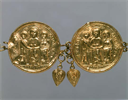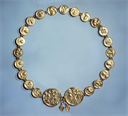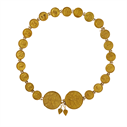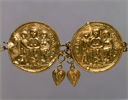| Showing 5 of 5 |
|
Photo Credit: © Dumbarton Oaks Research Library and Collection, Washington, D.C. Photography by Neil Greentree.
Marriage Belt
Early Byzantine
late 6th century - early 7th century
4.8 x 75.5 cm (1 7/8 x 29 3/4 in.)
gold
BZ.1937.33
On view
Permalink:
http://museum.doaks.org/objects-1/info/27445
Keywords
This object has the following keywords:
Beaded,
Brides,
Child,
Chitons,
Christ|Jesus Christ,
Concordia,
Cross Nimbus,
Dextrarum Iunctio|Joining of the Hands,
Dionysus,
Equal Armed Cross|Equal Armed Crosses,
Fibulae,
Grace,
Greek,
Headdresses|Helmets,
Health,
Leaf-Like|Leaves,
Staff God|Staffed Deity|Staff Deity,
Thrysus|Thrysos
- Beaded
- Brides
- Child
- Chitons
- Christ|Jesus Christ
- Concordia
- Cross Nimbus
- Dextrarum Iunctio|Joining of the Hands
- Dionysus
- Equal Armed Cross|Equal Armed Crosses
- Fibulae
- Grace
- Greek
- Headdresses|Helmets
- Health
- Leaf-Like|Leaves
- Staff God|Staffed Deity|Staff Deity
- Thrysus|Thrysos
Object Last Modified: 6/10/2024









